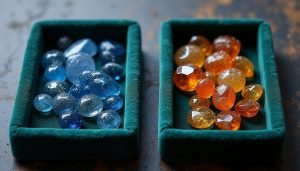In recent years, the diamond industry has seen a remarkable transformation. The introduction of lab-grown diamonds has sparked considerable interest and debate among consumers, jewelers, and environmental advocates alike. But how are these lab-grown diamonds different from their natural counterparts? In this blog post, we will delve into the key distinctions between lab-grown and natural diamonds, exploring their formation processes, physical characteristics, ethical implications, and market dynamics. By the end, you will have a clearer understanding of these two types of diamonds, which will assist you in making an informed choice when purchasing such a valuable gemstone.
What Are Lab-Grown Diamonds?
Lab-grown diamonds, also referred to as synthetic diamonds or cultured diamonds, are real diamonds created in a controlled laboratory environment. Their development involves replicating the natural process of diamond formation that occurs deep within the Earth. Two primary methods are used to produce lab-grown diamonds: High Pressure High Temperature (HPHT) and Chemical Vapor Deposition (CVD).
In the HPHT method, scientists mimic the conditions under which natural diamonds form, using extreme pressure and heat to convert carbon into a diamond crystal. Meanwhile, the CVD method uses carbon-rich gases that are ionized to deposit thin layers of diamond on a substrate. Both methods yield diamonds that have the same physical, chemical, and optical properties as natural diamonds.

What Are Natural Diamonds?
Natural diamonds are formed over billions of years under the Earth’s crust, approximately 150 to 200 kilometers deep. They originate from carbon sources that undergo intense heat and pressure, resulting in the crystalline structure we recognize. Natural diamonds are mined from the Earth, often requiring extensive labor, time, and resources. This process makes them more scarce and historically contributes to their higher price point.
Formation Process Comparison
The formation processes of lab-grown and natural diamonds reflect their differences in origin.
Lab-Grown Diamond Formation
The lab-grown diamond formation can take weeks to months, depending on the method used. HPHT recreates natural conditions using a press, while CVD involves synthesizing diamonds through advanced technology. Both processes ensure that lab-grown diamonds exhibit identical physical and chemical properties to natural diamonds, such as hardness, refractive index, and thermal conductivity.
Natural Diamond Formation
Conversely, natural diamonds require millions to billions of years to develop through geological processes. They formed during significant geological events and were brought closer to the Earth’s surface through volcanic eruptions. Their long and complex formation contributes to their allure and rarity, aspects that many consumers cherish.
Physical and Chemical Properties
One of the most salient points of confusion lies in the physical and chemical properties of lab-grown and natural diamonds. Both types of diamonds are composed of carbon atoms arranged in a crystal lattice, giving them their remarkable hardness.
Identical Properties
Despite the differences in formation processes, lab-grown diamonds are classified as real diamonds. Both types possess the same properties, which include:
- Hardness: Both lab-grown and natural diamonds score a perfect 10 on the Mohs scale of hardness.
- Clarity: Both can exhibit inclusions, though lab-grown diamonds typically have fewer, making them appear clearer.
- Color: Both types can come in various colors, including colorless, yellow, blue, and pink, depending on the presence of certain elements or defects during their formation.
- Brilliance: The optical properties, such as brilliance and fire, remain consistent across both diamond types, making them equally captivating.
Identifying the Difference
Despite their identical properties, gemologists can distinguish between lab-grown and natural diamonds using advanced tools and techniques. They may detect slight differences in the growth patterns or the presence of specific inclusions unique to lab-grown diamonds.
Ethical Considerations
One of the most significant discussions surrounding lab-grown versus natural diamonds pertains to ethical considerations and environmental impact. The diamond mining industry has faced criticism for ethical concerns, including labor rights violations, environmental degradation, and funding conflict zones.
Further Reading:
Lab-Grown Diamonds and Ethical Sourcing
Lab-grown diamonds present a transparent alternative. They are created in controlled environments, devoid of human rights violations or environmental exploitation. Thus, consumers who choose lab-grown diamonds can feel better about their purchase knowing that they are making an ethical choice.
Environmental Impact
The environmental impact of mining is substantial, involving habitat destruction, carbon emissions, and water pollution. In contrast, lab-grown diamonds significantly reduce carbon footprints, aligning with sustainable practices that appeal to eco-conscious consumers.
Market Trends and Pricing
Understanding the market for lab-grown and natural diamonds can help consumers navigate their purchasing decisions.
Pricing Structure
Lab-grown diamonds typically cost 20% to 40% less than their natural counterparts. This price difference is primarily due to the control over supply and demand dynamics, leading to affordability without compromising quality.
Consumer Trends
As awareness about ethical sourcing and environmental impact grows, consumer preferences are evolving. Many buyers are now leaning towards lab-grown diamonds due to their price advantages and ethical considerations. However, natural diamonds still hold sentimental and historical significance, which many consumers appreciate.

Resale Value and Longevity
Another aspect worth considering is the resale value of diamonds. Natural diamonds have traditionally held their value well and can appreciate over time due to their scarcity. However, lab-grown diamonds typically do not retain value in the same way; their resale market remains less established, and price depreciation can occur as more lab-grown diamonds enter the market.
Conclusion
In summary, lab-grown diamonds and natural diamonds each have distinct characteristics that cater to different consumer preferences. Lab-grown diamonds offer a sustainable, ethical, and affordable option for modern shoppers seeking elegance without the ethical concerns often associated with natural diamond mining. On the other hand, natural diamonds continue to be revered for their historical significance and rarity. Ultimately, the choice between a lab-grown and natural diamond depends on individual values, priorities, and budget. With the knowledge and understanding of both options, you can confidently make a decision that resonates with your values and desires.








